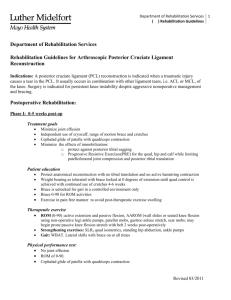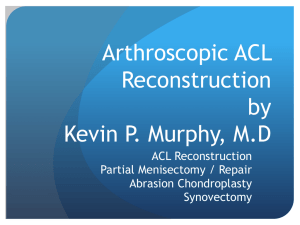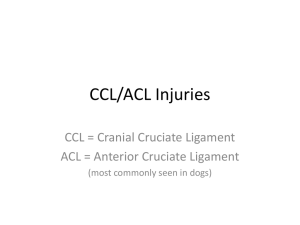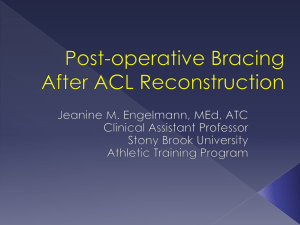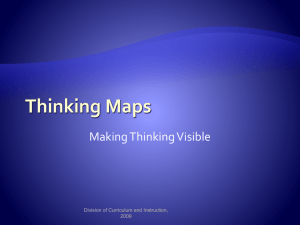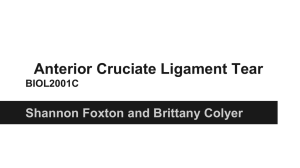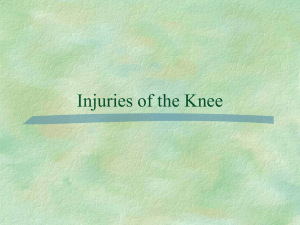rehabilitation guidelines fot patients undergoing surgery
advertisement
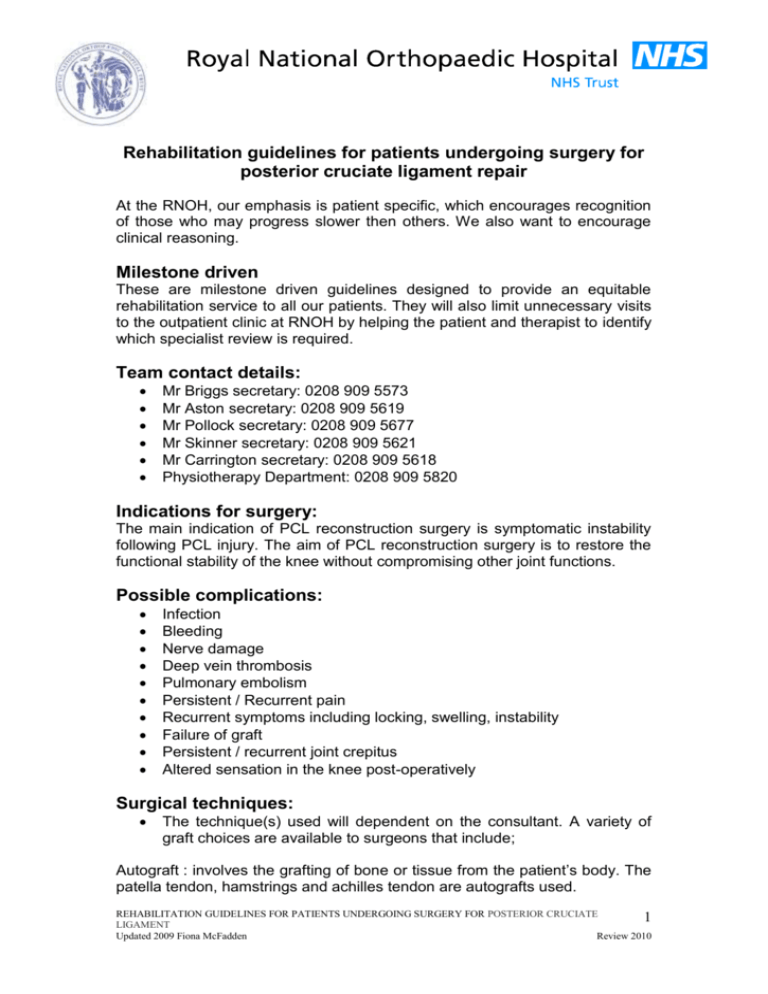
Rehabilitation guidelines for patients undergoing surgery for posterior cruciate ligament repair At the RNOH, our emphasis is patient specific, which encourages recognition of those who may progress slower then others. We also want to encourage clinical reasoning. Milestone driven These are milestone driven guidelines designed to provide an equitable rehabilitation service to all our patients. They will also limit unnecessary visits to the outpatient clinic at RNOH by helping the patient and therapist to identify which specialist review is required. Team contact details: Mr Briggs secretary: 0208 909 5573 Mr Aston secretary: 0208 909 5619 Mr Pollock secretary: 0208 909 5677 Mr Skinner secretary: 0208 909 5621 Mr Carrington secretary: 0208 909 5618 Physiotherapy Department: 0208 909 5820 Indications for surgery: The main indication of PCL reconstruction surgery is symptomatic instability following PCL injury. The aim of PCL reconstruction surgery is to restore the functional stability of the knee without compromising other joint functions. Possible complications: Infection Bleeding Nerve damage Deep vein thrombosis Pulmonary embolism Persistent / Recurrent pain Recurrent symptoms including locking, swelling, instability Failure of graft Persistent / recurrent joint crepitus Altered sensation in the knee post-operatively Surgical techniques: The technique(s) used will dependent on the consultant. A variety of graft choices are available to surgeons that include; Autograft : involves the grafting of bone or tissue from the patient’s body. The patella tendon, hamstrings and achilles tendon are autografts used. REHABILITATION GUIDELINES FOR PATIENTS UNDERGOING SURGERY FOR POSTERIOR CRUCIATE 1 LIGAMENT Updated 2009 Fiona McFadden Review 2010 Allograft : is the use of bone or tissue from a donor’s (typically a cadaver’s body) body. Expected outcome: Improved function / mobility Improved pain relief Improved knee stability Return to low impact sports may be possible but strenuous sport unlikely Full recovery may take up to twelve months Pre-operatively: Where possible the patient will be seen pre-operatively, and with consent, the following assessed: Current functional levels General Health Social / Work / Hobbies Functional range of movement Balance / Proprioception Gait / mobility, including walking aids, orthoses Post-operative expectations Patient information leaflet issued Post-operative management explained Post-operatively: Always check the operation notes, and the post-operative instructions. Discuss any deviation from routine guidelines with the team concerned. REHABILITATION GUIDELINES FOR PATIENTS UNDERGOING SURGERY FOR POSTERIOR CRUCIATE 2 LIGAMENT Updated 2009 Fiona McFadden Review 2010 Initial rehabilitation phase 0-6 weeks Goals: To be safely and independently mobile with appropriate walking aid, adhering to weight bearing status, which is usually PWB unless otherwise indicated by the consultant To be independent with home exercise programme as appropriate To understand self management / monitoring, e.g. skin sensation, colour, swelling, temperature, etc To be able to don and doff hinge knee brace safely Restrictions: Ensure that partial weight bearing restrictions are adhered to Wear hinge brace locked at 20 º for 3/52. After 3 weeks brace can be adjusted and locked at 0º when mobilising. At 3 weeks post op, brace can be unlocked for exercises to work towards 0°-60° ROM. If sedentary employment, may be able to return to work from 2-4 weeks post-operatively, as long as provisions to elevate leg, and no complications Treatment: Pain-relief: Ensure adequate analgesia Exercises: Example of exercises o Deep breathing and circulatory exercises o Static quadriceps, co-contraction of hamstring/quadriceps and active ankle ROM Advice / Education: Teach how to monitor sensation, colour, circulation, temperature, swelling, and advise what to do if concerned Swelling Management: Teach protection, rest, icing, compression and elevation (PRICE) Mobility: ensure patient independent with transfers and mobility, including stairs if necessary according to weight bearing status and with appropriate aid Brace: Ensure brace fits and patient understands how to don and doff brace as appropriate Electrotherapy if appropriate REHABILITATION GUIDELINES FOR PATIENTS UNDERGOING SURGERY FOR POSTERIOR CRUCIATE 3 LIGAMENT Updated 2009 Fiona McFadden Review 2010 On discharge from ward: Independent and safe mobilising, including stairs with appropriate aid Independent and safe with home exercise programme Independent with swelling management Ongoing out-patient physiotherapy arranged for within 6 weeks post op REHABILITATION GUIDELINES FOR PATIENTS UNDERGOING SURGERY FOR POSTERIOR CRUCIATE 4 LIGAMENT Updated 2009 Fiona McFadden Review 2010 Recovery rehabilitation phase 6 weeks – 12 weeks Goals: Increase to FWB using appropriate walking aids safely 0°-90 º at 12 weeks post op Restrictions: At 6 weeks post op hinge knee brace can be adjusted to 0°-90° working towards 0°-90° ROM at 12 weeks post op No formal weight bearing restrictions; weight bear as tolerated Treatment Pain relief Advice / Education Posture advice / education Mobility: ensure safely and independently mobile. Progress off walking aids as able once appropriate and safe. Gait Re-education Exercises: Example of exercises: Active assisted range of movement (AAROM) within ROM restrictions Active range of movement (AROM) with ROM restrictions Strengthening of muscles stabilising the knee progressing resistance with theraband/weights and/or COG shift as appropriate Core stability work and gluteal control work Balance / Proprioception progress unilateral exercises with unstable BOS and COG shift. Review lower limb biomechanics and kinetic chain, addressing issues as appropriate Biofeedback may be used if altered sequencing of muscles Swelling Management Manual Therapy: o Soft tissue techniques as appropriate o Joint mobilisations as appropriate Monitor sensation, swelling, colour, temperature, etc Hydrotherapy if appropriate Pacing advice as appropriate Electrotherapy if appropriate Brace Hinge brace set at 0-30 º at 6/52 post operatively and gradually increasing to 0 - 60 º at 12/52 as comfort allows. Unlock brace when mobilising when sufficient knee control is achieved REHABILITATION GUIDELINES FOR PATIENTS UNDERGOING SURGERY FOR POSTERIOR CRUCIATE 5 LIGAMENT Updated 2009 Fiona McFadden Review 2010 Milestones to progress to next phase: Mobilising FWB independently progressing walking aid as appropriate with hinge brace in situ, unlocking brace when knee control adequate Achieving 0-90 º within hinge brace Bilaterally equal propriocepton tests on single leg stance Failure to meet milestones: Refer back to team / Discuss with team Refer to failure to progress chart REHABILITATION GUIDELINES FOR PATIENTS UNDERGOING SURGERY FOR POSTERIOR CRUCIATE 6 LIGAMENT Updated 2009 Fiona McFadden Review 2010 Rehabilitation phase 3 months – 1 year Goals: Wean off brace and mobilise independently Gain full knee AROM 1RM single leg press RSI greater than or equal to 125% Calculation of Relative Strength Index (RSI (%) = weight pushed (kg) ÷ bodyweight (kg) × 100) LSI 85% - 100% of knee extensors Calculation of Limb Symmetry Index (LSI (%) = injured limb score ÷ uninjured limb score × 100) Symmetry on hop tests ie multiple single hop stabilization test, single leg hop for distance If satisified criteria for functional testing then for graded return to sport if set as patient goal Establish long term maintenance programme Restrictions: No restrictions may discard hinge brace, as knee control allows No jogging until proprioception on an uneven surface, knee valgus control when leaping and unilateral closed kinetic chain squat with knee valgus control is achieved. Return to sport when has satisfied functional performance testing requirements and when consultant has agreed for patient to return to sport: this is expected to be after 1 year post-operatively Return to breast stroke swimming at 4/12 Treatment: Mobility / function: Progression of mobility and function, increasing dynamic control with specific training to functional goals Gait Re-education Exercises: Jogging progressing to change of direction and rotation component as appropriate Plyometrics Jump training Agility training Hop tests Multiple single hop stabilization test Strengthening through range to include OKC quadriceps if appropriate Introduction of sports specific and occupation specific rehabilitation REHABILITATION GUIDELINES FOR PATIENTS UNDERGOING SURGERY FOR POSTERIOR CRUCIATE 7 LIGAMENT Updated 2009 Fiona McFadden Review 2010 Core stability and gluteal control work Stretches of tight structures as appropriate. Review lower limb biomechanics and kinetic chain, addressing issues as appropriate Balance / Proprioception work progressing to unstable BOS and COG shift Progress from static to dynamic exercises as appropriate. Wean from brace once gained sufficient proprioceptive control and strength around the knee Review lower limb biomechanics and kinetic chain, addressing issues as appropriate Swelling Management Manual Therapy: o Soft tissue techniques as appropriate o Joint mobilisations as appropriate Pacing advice Electrotherapy if appropriate Hydrotherapy if appropriate Milestones for discharge: Independently mobile unaided without hinge brace Good knee control and muscle strength Achieving full AROM Good proprioceptive control dynamically. Return to normal functional level. Return to sport if set as goal; satisfied criteria for functional testing and return to sports if set as patient goal. Failure to meet milestones: Refer back to team / Discuss with team Refer to failure to progress chart REHABILITATION GUIDELINES FOR PATIENTS UNDERGOING SURGERY FOR POSTERIOR CRUCIATE 8 LIGAMENT Updated 2009 Fiona McFadden Review 2010 Failure to progress If a patient is failing to progress, then consider the following: POSSIBLE PROBLEM Swelling Pain Breakdown of wound inflammation, bleeding, infection Recurrent Instability Numbness / altered sensation ACTION Ensure elevating leg regularly. Use ice as appropriate if normal skin sensation and no contraindications. Decrease amount of time on feet. Pacing. Use walking aids. Circulatory exercises. Modify exercise programme as appropriate. Should continue isometric work at all times. If decreases overnight, monitor closely. If does not decrease over a few days, refer back to surgical team Decrease activity. Ensure adequate analgesia. Elevate regularly. Decrease weight bearing and use walking aids as appropriate. Pacing. Modify exercise programme as appropriate. Should continue isometric work at all times. If persists, refer back to surgical team. e.g. Refer to surgical team. Refer back to surgical team. Ensure exercise progressions are at suitable level for patient. Address core stability. Review immediate post-operative status if possible. Ensure swelling under control. If new onset or increasing refer back to surgical team. If static, monitor closely, but inform surgical team and refer back if deteriorates or if concerned. REHABILITATION GUIDELINES FOR PATIENTS UNDERGOING SURGERY FOR POSTERIOR CRUCIATE 9 LIGAMENT Updated 2009 Fiona McFadden Review 2010 Appendix 1 Calculation of Limb Symmetry Index LSI (%) = injured limb score ÷ uninjured limb score × 100 Calculation of Relative Strength Index RSI (%) = weight pushed (kg) ÷ bodyweight (kg) × 100 Summary of evidence for physiotherapy guidelines A comprehensive literature search was carried out to identify research relating to rehabilitation following posterior cruciate ligament of the knee. After the reviewing the articles and information, the physiotherapy guidelines were produced on the best available evidence. Clark N (2001) Functional performance testing following knee ligament injury. Phyysical Therapy in Sport 2, 91-105. Dick F 1989 Sports Training Principles, 2nd edn, A & C Black, London Heyward V 1998 Advanced fitness assessment and exercise prescription, 3 rd edn. Human Kinetics, Illinois Sapega A 1990 Muscle performance evaluation in orthopaedic practice. Journal of Bone and Joint Surgery 72A (10): 1562-1574 REHABILITATION GUIDELINES FOR PATIENTS UNDERGOING SURGERY FOR POSTERIOR CRUCIATE 10 LIGAMENT Updated 2009 Fiona McFadden Review 2010
